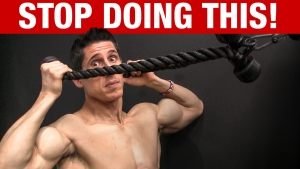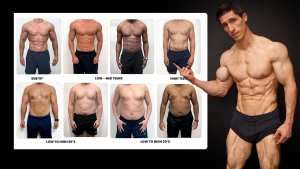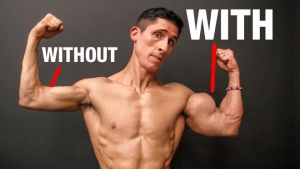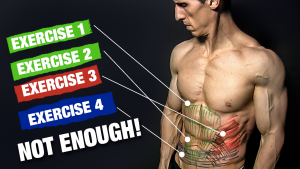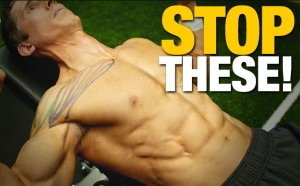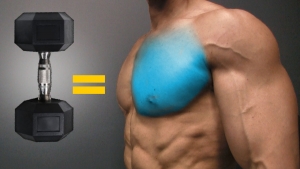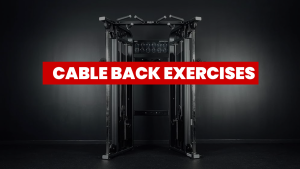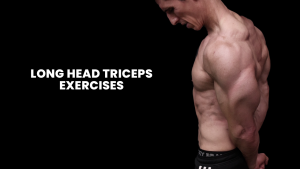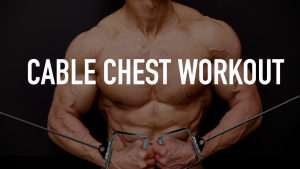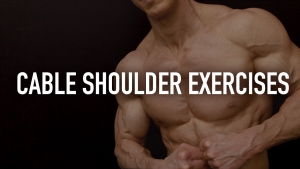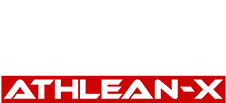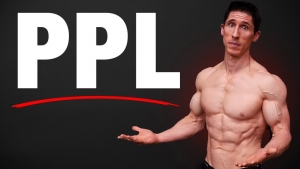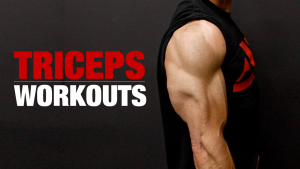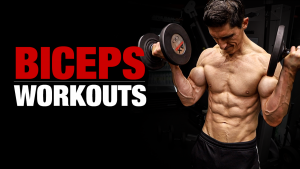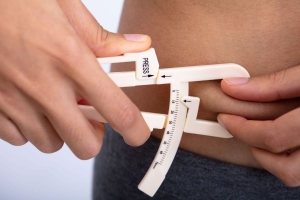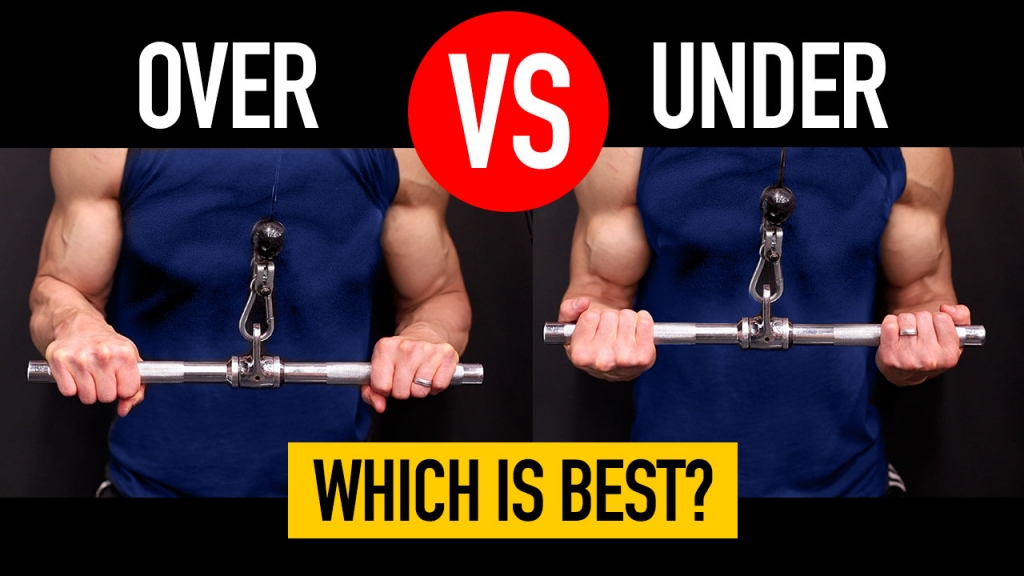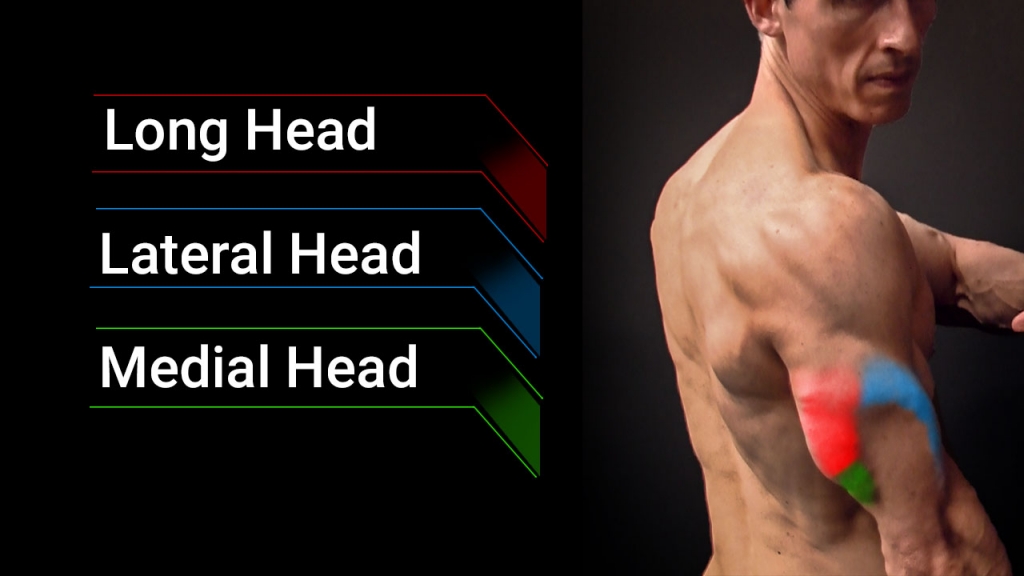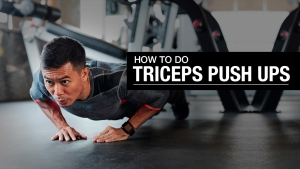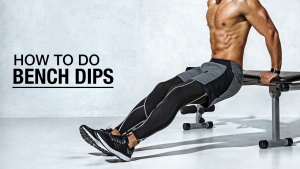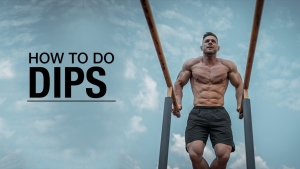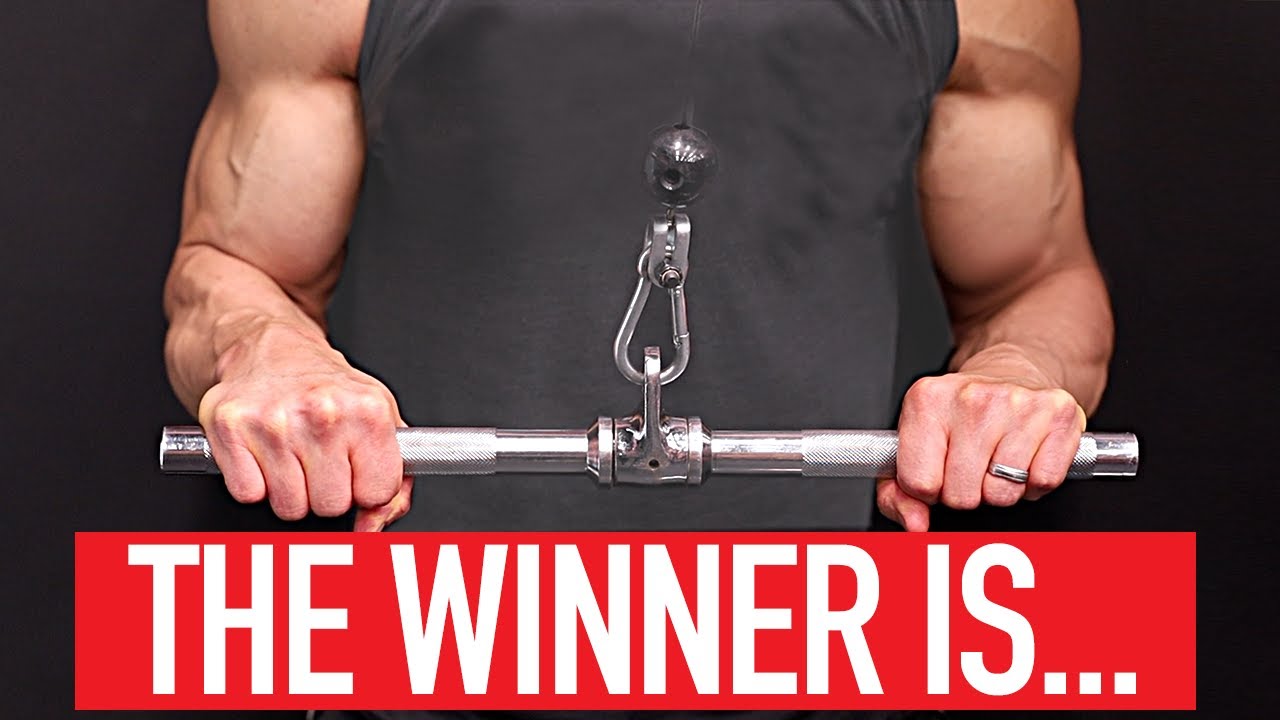
BEST TRICEPS PUSHDOWN VARIATION
When you’re trying to build big triceps, the pushdown grip you choose matters.
There are many variations of the tricep pushdown exercise that use a straight bar or a selection of grip attachments for cable machines designed to isolate triceps, like the EZ Curl bar, the V-Bar and the triceps rope attachment (for a rope pushdown).
They are all attempting to accomplish the same job: make this isolation movement more comfortable by aligning the grip with the natural correct position of the arms during extension.
With all these equipment options and different grips available, which pushdown variation is better for building up that big muscle that contributes to more than half of total upper arm size?
In this triceps pushdown exercise guide, I’ll be showing to you how grip difference between overhand or underhand can make a difference when it comes to the triceps pushdown.
TRICEPS PUSHDOWN: OVERHAND VS UNDERHAND GRIP
Which grip is best for the triceps pushdown, overhand or underhand?
To find the right pushdown version, stand up, straighten your arms with palms down towards the ground, and do a pushdown motion to create a hard triceps contraction.
Hold it for about two or three seconds.

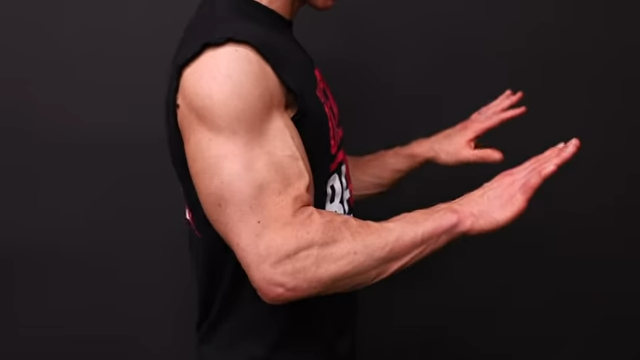
Now, take your arms, shake them out. Then, do the pushdown motion with palms up and contract your triceps as hard as possible.

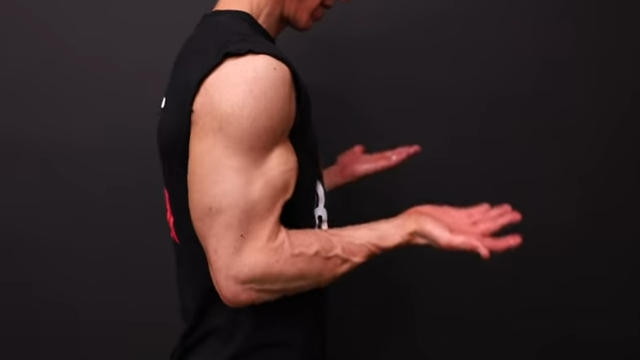
You’ll feel the difference between palms down (pronation) and palms up (supination) and wonder why you stopped doing the underhand grip push down.
It was probably because you’ve been told it doesn’t matter anatomically to the triceps whether your hand is in pronation or supination, and that’s correct.
There is no impact on the triceps, whether the hands are supinated or pronated. Because the triceps attaches to the common triceps tendon occurring on the olecranon rather than the radius, it is not directly influenced at all by movement of the forearm.
Or so we think.
Watch your biceps when your arms are in that pushdown position, then pronate and supinate your hands, and you’ll see that it impacts the contraction of the biceps. That’s because the biceps attach to the radius (so-called because of the radial motion it creates when the wrist position rotates).

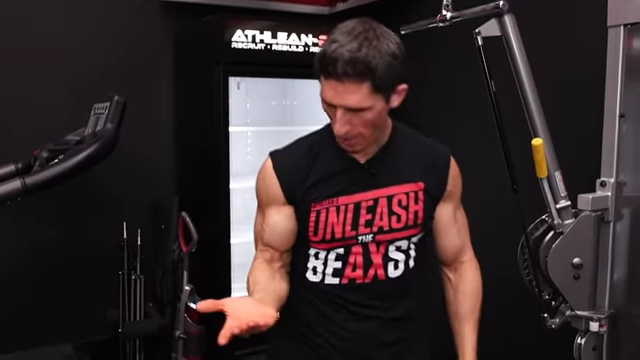
Something major you don’t see happens when you get into an overhand or underhand pushdown grip. We move more than just the forearm when we do supination or pronation and impact some other things.
We bring in internal and external rotation of the shoulder as we pronate and supinate the forearm.
And we also have an impact on the elbow’s position in relation to the body. This is where the difference between overhand or underhand grip comes into play.

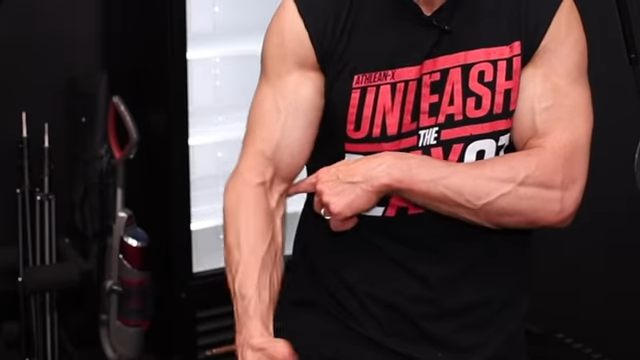
BEST GRIP FOR TRICEPS PUSHDOWN
To build bigger triceps, the underhand grip is better than overhand. Here’s why.
An overhand grip encourages the lifter to externally rotate the shoulder with pronation and an underhand grip internally rotates with supination. This influences the position of the elbow joint, and the elbow position relative to the body is most important when working the triceps for isolation and muscle size.
The elbows drift outward with the overhand grip, even if only a little. Flaring of the elbow is unavoidable due to shoulder internal rotation. But with an underhand grip, you prevent that infamous elbow flare.
This is where the underhand pushdown (also called reverse-grip triceps pushdown) shines.
Flipping to an underhand grip adducts the elbow so that it’s tucked nice and tight to the side with the arm back, which allows for more arm extension at the shoulder when in the fully contracted position.
The farther behind the body you can get your arm and the tighter to your side you can position the elbow, the greater the range of motion and the more fully you can contract the long head of the triceps muscle, which is the key muscle you’re trying to activate. So that you know where each of the heads of the triceps are located, refer to the graphic below to see long head, lateral head and medial heads.
CHOOSE THE RIGHT PUSHDOWN HANDLES
The only limitation to the underhand pushdown is the demand on the wrist. The solution is in handle selection.
If you don’t have a cable pulley machine, you can use bands. Bands provide comfortable grip options. Attach two bands to a pull up bar. Grab each band underhand to do a resistance band triceps pushdown.

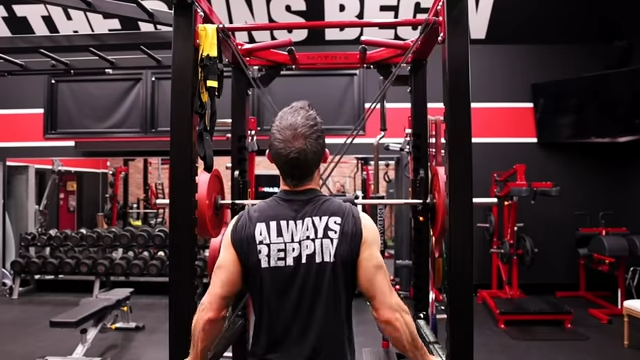
If you’re in a gym that has a two-pulley cable machine, grab the left handle with the right arm and the right handle with the left arm and cross the cables as you pull down.

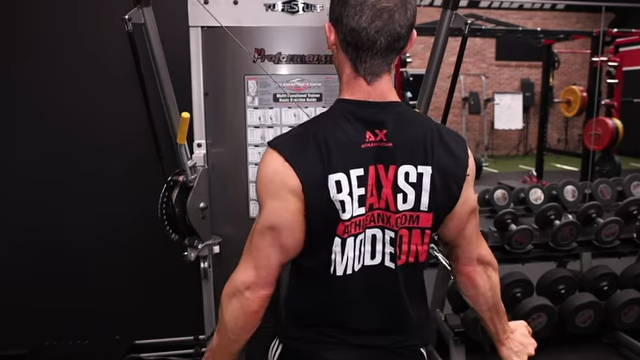
USE LESS WEIGHT TO ISOLATE
You’ll get more size benefit by using lighter weight and a modified underhand grip.
Just because you’re not lifting a lot of heavy weight doesn’t mean you won’t be stressing the triceps as much as you can with a different grip or triceps exercise.
The reason why you can’t do as much weight is because the overhand version of the triceps pushdown motion recruits a lot of other muscles: the chest muscles, the shoulders, and even the abdominal muscles.
Performing tricep isolation exercises by removing other muscles is key if you want to hypertrophy the triceps.
If it’s just triceps strength gains that you’re looking for, do other strength exercises like the Triceps Close Grip Bench Press, Triceps Weighted Dips, and Skull Crushers. Don’t bastardize the pushdown by using the jackhammer-like motion you often see in the gym, just so you can do more weight.
To introduce a new stress, try an underhand grip and you’ll see what you’re missing by doing an overhand-dominant Triceps Pushdown down only.
Once again we’ve put the science back into triceps training to help you get the most out of your triceps workouts.
If you’re looking for a complete program that incorporates science into everything we do, check out our ATHLEAN-X programs.
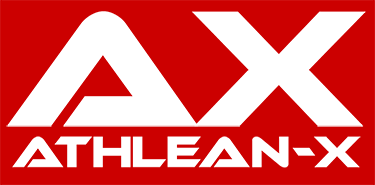
- There are several variations for the triceps pushdown exercise, and a wide range of equipment options. So, which is best?
- When it comes to building bigger triceps and not just training for tricep strength, grip matters as much as selecting the right triceps movements.
- Overhand straight bar cable pushdowns cause other muscles to work simply due to the kinetic chain.
- Reverse-grip triceps pushdowns (underhand grip) on a straight bar offer more isolation because greater muscle contraction is possible due to shoulder and elbow joint position.
- Using single handles or a band improves further on the underhand grip by allowing natural rotation of the joint and providing an even greater range of motion where hands can move behind the body.
TRICEP PUSHDOWN FAQS
The underhand tricep pushdown (or Reverse Grip Triceps Pushdown) is the best tricep pushdown variation if performed with proper form because it helps keep the elbow adducted and tucked nicely into the side which allows for more extension at the shoulder. This extension gives you a greater range of motion to help you more fully contract the long triceps head to achieve more muscle growth and arm strength.
To do a tricep pushdown, stand in front of a cable pulley machine with a straight bar attachment or the attachment of your choice. You can choose an overhand (pronated grip) or an underhand grip, but an underhand grip is recommended for a more complete contraction of the long head of the triceps. Push or pull the attachment down and toward you to lift the weight. If you don’t have access to a cable machine, this exercise can also be performed using two bands attached to a pull up bar.
Tricep pushdowns are good for isolating and tricep muscle growth.
The tricep pushdown is a good exercise for building the tricep muscles, and the best variation is with an underhand grip (or the Reverse Grip Triceps Pushdown) because it keeps the elbow adducted and tucked into the side which allows more extension at the shoulder. This positioning helps give you a greater range of motion to allow you to more fully contract the long head of the triceps.
A tricep pushdown is an exercise that is usually done with a cable pulley machine. It can be done with a straight bar attachment, the EZ curl bar, the V-Bar or the triceps rope attachment. You can choose an overhand or an underhand grip, but an underhand grip is recommended for a more complete contraction of the long head of the triceps. Push or pull the cable pulley attachment down and toward you. If you don’t have access to a cable machine, this exercise can also be performed using two bands attached to a pull up bar.
REFERENCES
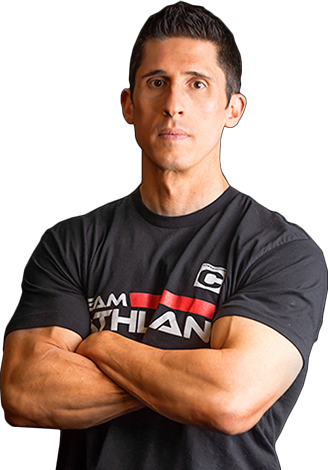
Jeff Cavaliere M.S.P.T, CSCS
Jeff Cavaliere is a Physical Therapist, Strength Coach and creator of the ATHLEAN-X Training Programs and ATHLEAN-Rx Supplements. He has a Masters in Physical Therapy (MSPT) and has worked as Head Physical Therapist for the New York Mets, as well as training many elite professional athletes in Major League Baseball, NFL, MMA and professional wrestling. His programs produce “next level” achievements in muscle size, strength and performance for professional athletes and anyone looking to build a muscular athletic physique.
